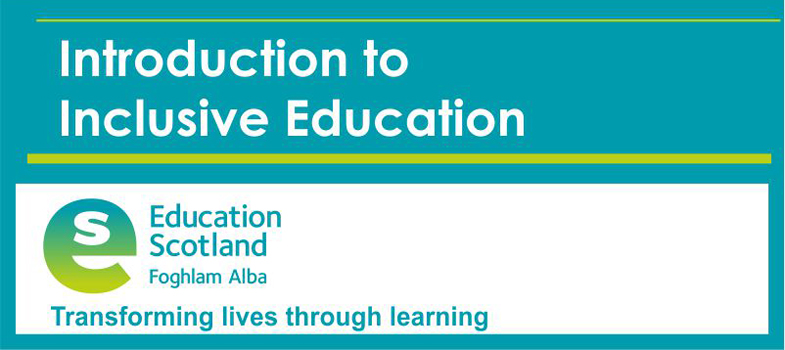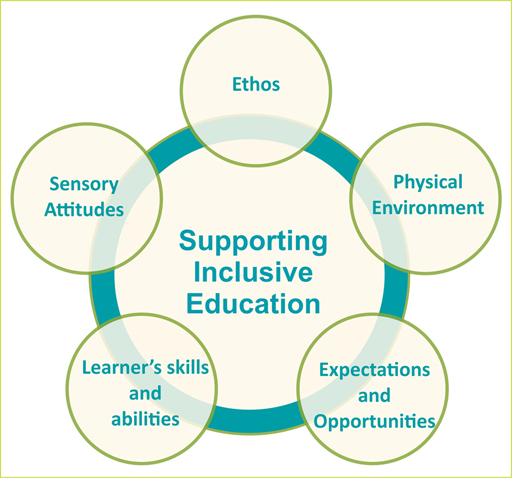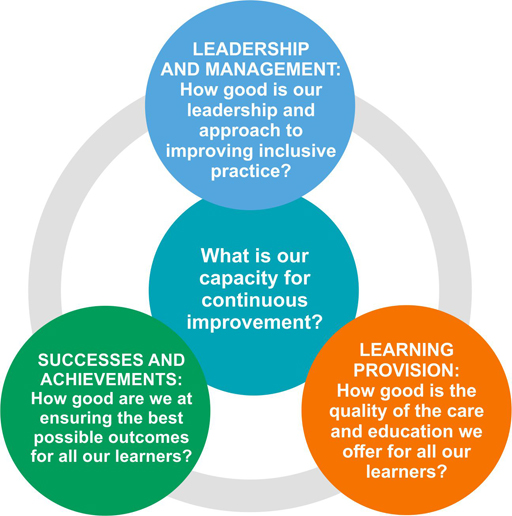4.1 The inclusive learning environment
Planning and developing an inclusive child centred approach to learning and teaching can support a range of additional support needs. An inclusive learning environment will support all learners to access the curriculum and participate in the range of experiences provided through a flexible, accessible and inclusive curriculum. A combination of factors supports the development of an inclusive school community and learning environment. Figure 12 highlights features of an inclusive classroom and learning community.
Curriculum accessibility
The curriculum includes all of the experiences which are planned for children and young people through their education. It is not specific to subject areas but applies to activities that take place across the school. An accessible curriculum is an inclusive curriculum.
A curriculum which is accessible to all learners enables schools and education authorities to meet:
- Legal responsibilities and statutory duties
- The needs of their learners, including those without Additional Support Needs, who can also learn effectively from appropriately planned and developed resources
- The standards for Curriculum for Excellence
- Management responsibilities - Cost effective use of time through appropriate planning – Use of IT, production of accessible digital resources which enable swift adaptation for different learners
- Their duty to provide equity of opportunity
Activity 12 Select the correct statement
a.
Subjects within a school’s curriculum are available to all learners - if they can meet the criteria, age and cognitive ability.
b.
The curriculum is defined by the subjects taught.
c.
The curriculum includes all of the experiences which are planned for children and young people through their education. It is not specific to subject areas but applies to activities that take place across the school.
d.
Pupils do not have an entitlement to engage with all aspects of the curriculum.
The correct answer is c.
Supporting improvement
‘How Good Is Our School 4’ (HGIOS 4) is a resource to support improvement through self-evaluation and inclusion and is embedded across all the themes and quality indicators.
Figure 13 highlights how the reflective questions can support school communities evaluate their inclusive practice and identify areas for improvement.
Activity 13
You will need to download this file
Download and read HGIOS 4. Identify which Quality Indicators you feel will support the improvement of inclusive practice for learners with additional support needs.
Leadership and Management
1.1 Self-evaluation for self-improvement
1.2 Leadership of learning
1.3 Leadership of change
1.4 Leadership and management of staff
1.5 Management of resources to promote equity
Learning Provision
2.1 Safeguarding and child protection
2.2 Curriculum
2.3 Learning, teaching and Assessment
2.4 Personalised support
2.5 Family learning
2.6 Transitions
2.7 Partnerships
Successes and Achievements
3.1 Ensuring wellbeing, equality and inclusion
3.2 Raising attainment and achievement
3.3 Increasing creativity and employability
Discussion
Supporting Inclusion is featured across all 3 categories and the 15 quality indicators within HGIOS 4. This self-evaluation framework is designed to promote effective self-evaluation as the first important stage in a process of achieving self-improvement. Reflecting on inclusion when evaluating practice to see what is working well and what needs to improve will support the educational experiences and outcomes for learners who for whatever reason experience barriers to learning.
A range of free resources and helpline services are available to provide information for schools and local authorities These free sources of information help provide an overview of the area concerned and suggest approaches to support learners and practitioners and improve the outcomes and experiences of learners who have additional support needs. When an understanding of the learner’s needs is developed the positive impact can also be experienced by the family. Further information on these services are available in section 6
4 Effective Planning


